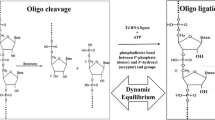Abstract
A spatially resolved model of RNA world is studied, where primer induced replication, concatenation and random cutting are considered. The increase of diversity of sequences and complexity of shapes are observed; A hierarchically orgnized “replication network” is formed, and evolution to long sequences and assembly of further long sequences are obtained through it. These results suggest a scenario for overcoming the error threshold and for the evolution of enzymatic activity.
Access this chapter
Tax calculation will be finalised at checkout
Purchases are for personal use only
Preview
Unable to display preview. Download preview PDF.
Similar content being viewed by others
References
Joyce, G.F., Orgel, L.E.: Prospects for understanding the origin of the RNA world. In Gesteland, R.F., Cech, T.R., Atkins, J.F., eds.: The RNA world, 2nd edition. Cold Spring Harbor Laboratory Press, Cold Spring Harbor, New York (1999) 49–77
Anderson, P.W. Proc. Natl. Acad. Sci. USA 80 (1983) 3386–3390
Eigen, M., Schuster, P.: The Hypercycle: A Principle of Natural Self-Organization. Springer-Verlag, Berlin (1979)
Swetina, J., Schuster, P. Biophysical Chemistry 16 (1982) 187–203
Inoue, T., Orgel, L.E. J. Am. Chem. Soc. 103 (1981) 7666–7667
James, K.D., Ellington, A.D. Chemistry and Biology 4 (1997) 595–605
Breyer, J., Ackermann, J., McCaskill, J. Artificial Life 4 (1998) 25–40
Toffoli, T., Margolus, N.: Cellular Automata Machines. MIT Press, Cambridge (1987)
Hofacker, I.L., Fontana, W., Stadler, P.F., Bonhoeffer, S., Tacker, M., Schuster, P. Monatshefte f. Chemie 125 (1994) 167–188
Konings, D., Hogeweg, P. J. Mol. Biol. 207 (1989) 597–614
Author information
Authors and Affiliations
Editor information
Editors and Affiliations
Rights and permissions
Copyright information
© 1999 Springer-Verlag Berlin Heidelberg
About this paper
Cite this paper
Yamamoto, T., Hogeweg, P. (1999). Evolution to Complexity: Replication, Elongation and Assembly in an RNA World. In: Floreano, D., Nicoud, JD., Mondada, F. (eds) Advances in Artificial Life. ECAL 1999. Lecture Notes in Computer Science(), vol 1674. Springer, Berlin, Heidelberg. https://doi.org/10.1007/3-540-48304-7_58
Download citation
DOI: https://doi.org/10.1007/3-540-48304-7_58
Publisher Name: Springer, Berlin, Heidelberg
Print ISBN: 978-3-540-66452-9
Online ISBN: 978-3-540-48304-5
eBook Packages: Springer Book Archive




